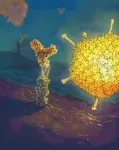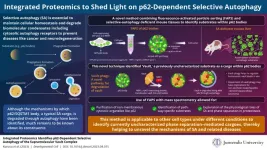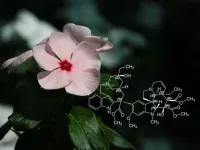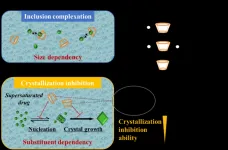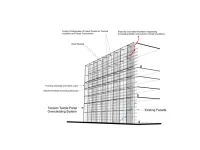(Press-News.org) TORONTO - A new international study published in Nature Medicine and presented as a late-breaking abstract at the American Association of Neurological Surgeons (AANS) annual conference, shows great promise for patients with glioblastoma.
Drs. Farshad Nassiri and Gelareh Zadeh, neurosurgeons at the University Health Network (UHN) in Toronto, published the results of a Phase 1/2 clinical trial investigating the safety and effectiveness of a novel therapy which combines the injection of an oncolytic virus – a virus that targets and kills cancer cells - directly into the tumour, with intravenous immunotherapy.
The authors found that this novel combination therapy can eradicate the tumour in select patients, with evidence of prolonged survival.
Investigative work by the authors also revealed a new genetic signature within tumour samples that has the potential to predict which patients with glioblastoma are most likely to respond to treatment.
“The initial clinical trial results are promising,” says Dr. Zadeh, who is also Co-Director of the Krembil Brain Institute and a Senior Scientist at the Princess Margaret Cancer Centre. “We are cautiously optimistic about the long-term clinical benefits for patients.”
Glioblastoma is a notoriously difficult-to-treat primary brain cancer. Despite aggressive treatment, which typically involves surgical removal of the tumour and multiple chemotherapy drugs, the cancer often returns, at which point treatment options are limited.
Immune checkpoint inhibitors are effective treatments for a variety of cancers, but they have had limited success in treating recurrent glioblastoma. This novel therapy involves the combination of an oncolytic virus and immune checkpoint inhibition, using an anti-PD-1 antibody as a targeted immunotherapy.
First, the team delivered the virus by accurately localizing the tumour using stereotactic techniques and injecting the virus through a small hole and a purpose-built catheter. Then, patients received an anti-PD-1 antibody intravenously, every three weeks, starting one week after surgery.
“These drugs work by preventing cancer’s ability to evade the body’s natural immune response, so they have little benefit when the tumour is immunologically inactive—as is the case in glioblastoma,” explains Dr. Zadeh.
“Oncolytic viruses can overcome this limitation by creating a more favourable tumour microenvironment, which then helps to boost anti-tumour immune responses.”
The combination of the oncolytic virus and immune-checkpoint inhibition results in a ‘double hit’ to tumours; the virus directly causes cancer cell death, but also stimulates local immune activity causing inflammation, leaving the cancer cells more vulnerable to targeted immunotherapy.
Dr. Zadeh and colleagues evaluated the innovative therapy in 49 patients with recurrent disease, from 15 hospital sites across North America.
UHN, which is the largest research and teaching hospital in Canada and the only Canadian institution involved in the study, treated the majority of the patients enrolled in the trial.
The results, published in Nature Medicine, show that this combination therapy is safe, well tolerated and prolongs patient survival. The therapy had no major unexpected adverse effects and yielded a median survival of 12.5 months—considerably longer than the six to eight months typically seen with existing therapies.
“We’re very encouraged by these results,” says Dr. Farshad Nassiri, first author of the study and a senior neurosurgery resident at the University of Toronto. “Over half of our patients achieved a clinical benefit - stable disease or better - and we saw some remarkable responses with tumours shrinking, and some even disappearing completely. Three patients remain alive at 45, 48 and 60 months after starting the clinical trial.”
“The findings of the study are particularly meaningful as the patients in the trial did not have tumour resection at recurrence - only injection of the virus - which is a novel treatment approach for glioblastoma. So, it’s really remarkable to see these responses,” says Dr. Zadeh.
“We believe the key to our success was delivering the virus directly into the tumour prior to using systemic immunotherapy. Our results clearly signal that this can be a safe and effective approach,” adds Dr. Nassiri.
The team also performed experiments to define mutations, gene expression, and immune features of each patient’s tumour. They discovered key immune features which could eventually help clinicians predict treatment responses and understand the mechanisms of glioblastoma resistance.
“In general, the drugs that are used in cancer treatment do not work for every patient, but we believe there is a sub-population of glioblastoma patients that will respond well to this treatment,” says Dr. Zadeh. “I believe this translational work, combining basic bench science and clinical trials, is key to moving personalized treatments for glioblastoma forward.”
This is one of the few clinical trials with favourable results for glioblastoma over the last decade, and it was truly a team effort.
“The trial would not have been possible without our incredible OR teams, research safety teams and researchers - including Dr. Warren Mason and his team at Princess Margaret Cancer Centre - and our brave patients and their families. We’re also grateful to the Wilkins Family for providing the funds to enable us to complete trials that advance care for our patients,” says Dr. Zadeh.
The next steps for the group are to test the effectiveness of the combination therapy against other treatments in a randomized clinical trial.
“We are encouraged by these results, but there is still a lot of work ahead of us,” says Dr. Nassiri. “Our goal, as always, is to help our patients. That’s what motivates us to continue this research.”
This work was supported by the DNATrix Inc., Merck & Co. Inc., UHN Foundation and the Princess Margaret Cancer Centre Foundation. Dr. Gelareh Zadeh is a Professor in the Department of Surgery at the University of Toronto and holds the Dan Family Chair in Neurosurgery and the Wilkins Family Chair in Neurological Brain Tumour Research.
About the Krembil Brain Institute
The Krembil Brain Institute at Toronto Western Hospital, part of University Health Network, is home to one of the world’s largest and most comprehensive teams of physicians and scientists uniquely working hand-in-hand to prevent and confront problems of the brain and spine. One in three Canadians will experience a brain-related condition such as Parkinson’s, Alzheimer’s or epilepsy in their lifetime. Through state-of-the-art patient care and advanced research, we are working relentlessly to find new treatments and cures. For more information: https://www.uhn.ca/krembil
About the Princess Margaret Cancer Centre
The Princess Margaret Cancer Centre has achieved an international reputation as a global leader in the fight against cancer and delivering personalized cancer medicine. The Princess Margaret, one of the top five international cancer research centres, is a member of the University Health Network. For more information: www.theprincessmargaret.ca
About University Health Network
University Health Network consists of Toronto General and Toronto Western Hospitals, the Princess Margaret Cancer Centre, Toronto Rehabilitation Institute, and The Michener Institute of Education at UHN. The scope of research and complexity of cases at University Health Network has made it a national and international source for discovery, education and patient care. It has the largest hospital-based research program in Canada, with major research in cardiology, transplantation, neurosciences, oncology, surgical innovation, infectious diseases, genomic medicine and rehabilitation medicine. University Health Network is a research hospital affiliated with the University of Toronto. For more information: https://www.uhn.ca/
MEDIA CONTACTS
To speak with Dr. Zadeh or Dr. Nassiri:
Heather Sherman
Communications Manager, Krembil Brain Institute/UHN
heather.sherman@uhn.ca
To speak with Dr. Mason:
Marina Jimenez
Communications Director, Princess Margaret Cancer Centre
marina.jimenez@uhn.ca
END
New study using novel approach for glioblastoma treatment shows promising results, extending survival
Drs. Farshad Nassiri and Gelareh Zadeh, neurosurgeons at the University Health Network (UHN) in Toronto, published the results of a Phase 1/2 clinical trial investigating the safety and effectiveness of a novel therapy which combines the injection of an o
2023-05-15
ELSE PRESS RELEASES FROM THIS DATE:
Finding ‘vault’: Unravelling the mysteries of p62-bodies and the cellular recycling pathway
2023-05-15
Our body functioning is delicately balanced between the synthesis and breakdown of various cellular components. When these cellular components grow old or get damaged, they are digested by a process called “autophagy”—literally, “self-eating.” This process not only helps in the elimination of toxic wastes, but also helps to deliver building blocks for the synthesis of new cellular macromolecules. Thus, autophagy serves as the body's cellular cleaning and recycling system.
Researchers have long been studying the ...
Comprehensive analysis of single plant cells provides new insights into natural product biosynthesis
2023-05-15
Plants are impressive in their diversity, but especially in the variety of metabolites they produce. Many plant natural products are highly complex molecules, such as the alkaloids vincristine and vinblastine, which are produced by the Madagascar periwinkle Catharanthus roseus. These two substances are already indispensable in cancer therapy.
Researchers are very interested in finding out which individual biosynthetic steps are required to form the complex molecules. "Currently, these compounds are still obtained in very small quantities from the plant's leaf extract. We can learn from the plant how this compound is produced and use this knowledge ...
Dementia study reveals how toxic proteins spread through brain
2023-05-15
Fresh insights into the spread of damaging proteins that build up in the brains of people with Alzheimer’s disease could hold the key to stopping the condition progressing, a study says.
Researchers have discovered that synapses, which send essential signals through the brain, are also transporting toxic proteins known as tau around the brain.
Large clumps of the protein tau – called tangles – form in brain cells and are one of the defining features of Alzheimer’s disease. As these tangles spread through the brain during the disease there is a decline in ...
Combined delivery of engineered virus with immunotherapy is safe and improves outcomes in subset of patients with glioblastoma
2023-05-15
HOUSTON ― Intratumoral delivery of an engineered oncolytic virus (DNX-2401) targeting glioblastoma (GBM) cells combined with subsequent immunotherapy was safe and improved survival outcomes in a subset of patients with recurrent GBM, according to results from a multi-institutional Phase I/II clinical trial co-led by researchers at The University of Texas MD Anderson Cancer Center and the University of Toronto.
The study, published today in Nature Medicine, met its primary safety endpoint and demonstrated the combination was well tolerated overall with no dose-limiting toxicities. The study did not meet its primary efficacy endpoint of objective response rate, but ...
Mass General Brigham investigators identify new genetic variant protective against Alzheimer's disease
2023-05-15
A single patient can spark new research questions and provide answers about a disease. And when a new case is identified, investigators can make connections between them that can lead to even more powerful and persuasive ideas about cause and treatment. In a publication today in Nature Medicine, an international team led by investigators from two Mass General Brigham hospitals — Massachusetts General Hospital (MGH) and Mass Eye and Ear — reports on a new case of a patient with a genetic predisposition for developing early-onset Alzheimer’s disease who remained cognitively intact until his late 60s. Through clinical assessments ...
Out of this world control on Ice Age cycles
2023-05-15
A research team, composed of climatologists and an astronomer, have used an improved computer model to reproduce the cycle of ice ages (glacial periods) 1.6 to 1.2 million years ago. The results show that the glacial cycle was driven primarily by astronomical forces in quite a different way than it works in the modern age. These results will help us to better understand the past, present, and future of ice sheets and the Earth’s climate.
Earth’s orbit around the Sun and its spin axis orientation change slowly over time, due to the pull of gravity from the Sun, the Moon, and other planets. These astronomical forces affect the environment on Earth due to changes in ...
Methylated cyclodextrin effectively prevents the crystallization of supersaturated drugs
2023-05-15
In the medicine market, most newly introduced drugs and drug candidates show poor water solubility, which prevents their absorption in the body. This, in turn, limits their therapeutic efficiency. Solubilizing agents such as cyclodextrins (CDs) are commonly employed to enhance their solubility. CDs have a cyclic structure featuring a hydrophilic exterior and a hydrophobic cavity inside that can enclose drug molecules to form inclusion complexes. However, solubilization does not necessarily enhance drug adsorption in the body, since the solubilized drugs cannot ...
Translating science into impact: Cane-Bridge Foundation donates $1M to Boyce Thompson Institute for Innovative Translational Research Program
2023-05-15
Ithaca, NY (May 15, 2023) - Today, the Boyce Thompson Institute (BTI) is taking a significant step forward in its mission to bridge the gap between scientific discovery and real-world application. Thanks to a generous $1M gift from the Cane-Bridge Foundation, BTI has launched an innovative translational program called "Project Vault!" to propel plant science discoveries into applications that tackle global life science challenges.
"The Cane-Bridge Foundation's support is vital to accelerate ...
Latest research provides SwRI scientists close-up views of energetic particle jets ejected from the Sun
2023-05-15
SAN ANTONIO — May 15, 2023 —Southwest Research Institute (SwRI) scientists observed the first close-ups of a source of energetic particles expelled from the Sun, viewing them from just half an astronomical unit (AU), or about 46.5 million miles. The high-resolution images of the solar event were provided by ESA’s Solar Orbiter, a Sun-observing satellite launched in 2020.
“In 2022, the Solar Orbiter detected six recurrent energetic ion injections. Particles emanated along the jets, a signature of magnetic reconnection involving ...
New project to design building skins to retrofit energy-inefficient structures
2023-05-15
Older buildings tend to leak heat through their walls, requiring much more energy to maintain a comfortable temperature in summer or winter. Those constructed prior to the late 1970s rarely meet today’s more rigorous energy standards. And yet they account for large proportion of the buildings standing today. In the US, about 44% of the residential building stock was built before 1970 and about half of the commercial buildings that exist today were built before the 1980s, which creates a significant need for energy retrofitting to reduce environmental impact. A new industry-academic collaboration between Jefferson and Lightweight ...
LAST 30 PRESS RELEASES:
New Zealand researchers identify brain link to high blood pressure
New research confirms people with ME/CFS have a consistent faulty cellular structure
Hidden cancer risk behind fatty liver disease targets
Born in brightness, leading to darkness
Boron-containing Z-type and bilayer benzoxene
Hong Kong researchers break the single-field barrier with dual-field assisted diamond cutting
Work hard, play hard?
Wood becomes smart glass: Photo- and electro-chromic membrane switches tint in seconds
The Lancet: COVID-19 vaccine hesitancy decreased over time, though mistrust persists among certain groups, study of over 1 million people in England suggests
Psychosis patients ‘living in metaphor’ -- new study radically shifts ideas about delusions
Clinical trial in Ethiopia targets the trachoma scourge
Open-sourcing the future of food
Changes in genetic structure of yeast lead to disease-causing genomic instabilities
UC San Diego Health Sciences Grant Writing Course helps launch successful research careers
Study: Many head and neck cancer trials end early. Why?
Tufts vice provost for research named Foreign Fellow of Indian National Science Academy
New model improves prediction of prostate cancer death risk
Two wrongs make a right: how two damaging variants can restore health
Overlooked decline in grazing livestock brings risks and opportunities
Using rare sugars to address alcoholism
Research alert: New vulnerability identified in aggressive breast cancer
Ruth Harris honored with SSA Distinguished Service Award
Treasure trove of data on aging publicly accessible
Trees4Adapt project to address risks from climate change and biodiversity loss through tree-based solutions
Nature Communications study from the Lundquist Institute identifies molecular mechanism underlying peripartum cardiomyopathy
Pennington Biomedical’s Dr. Gang Hu appointed to NIH Reproductive, Perinatal and Pediatric Health Review Group
World-first project shows great promise to treat low eye pressure
New technique puts rendered fabric in the best light
Brain cancer digital twin predicts treatment outcomes
Cat disease challenges what scientists thought about coronaviruses
[Press-News.org] New study using novel approach for glioblastoma treatment shows promising results, extending survivalDrs. Farshad Nassiri and Gelareh Zadeh, neurosurgeons at the University Health Network (UHN) in Toronto, published the results of a Phase 1/2 clinical trial investigating the safety and effectiveness of a novel therapy which combines the injection of an o

